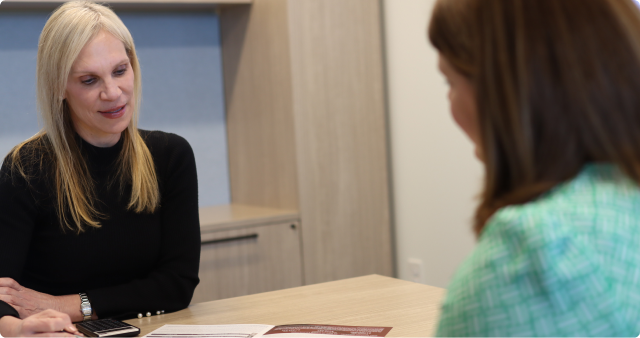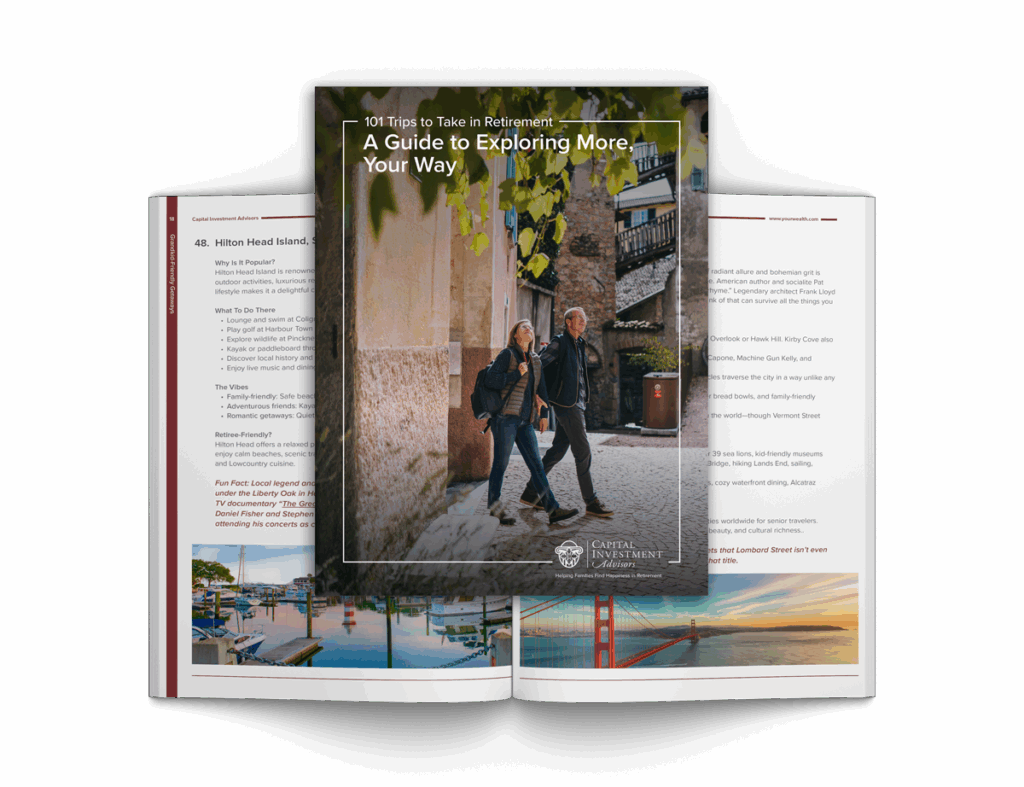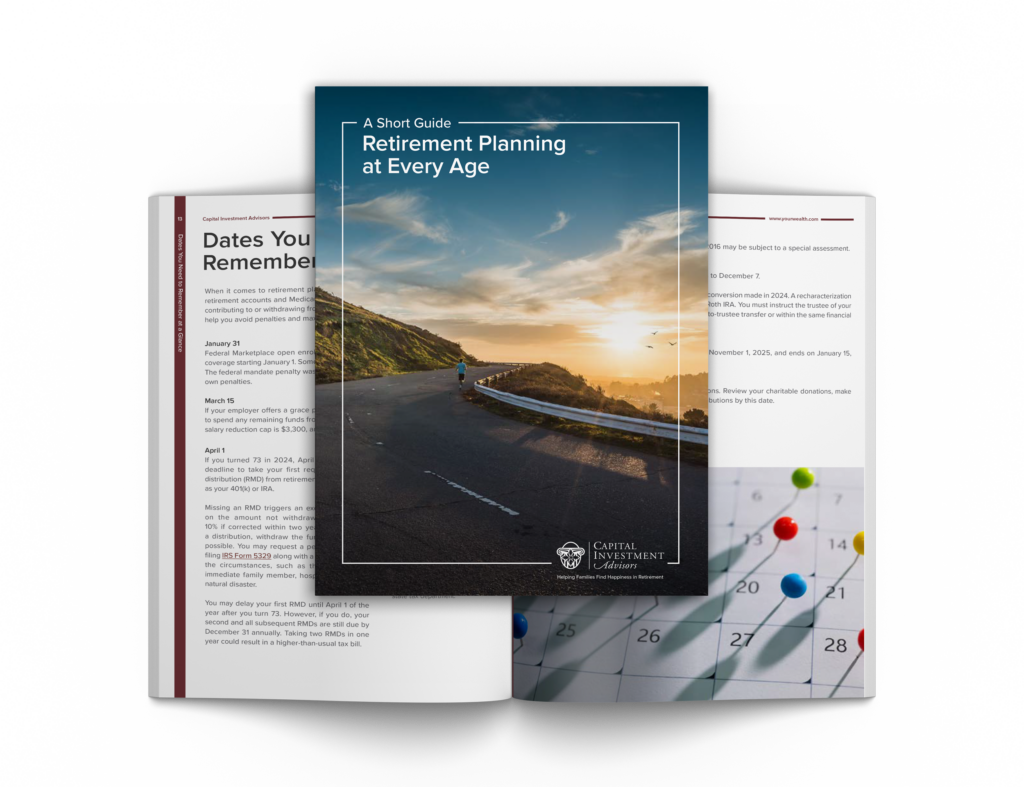Wes Moss and Conner Miller provide historical context and perspective on the latest financial news, including:
-
The markets staged a dramatic V-shaped recovery following tariff fears. Investors, take note: Volatility can reverse quickly. Once you’ve chosen a solid strategy, it’s often more productive to stay the course rather than letting fear drive decisions.
-
The S&P 500 dropped nearly 20% in April but rebounded in just six weeks. Panic rarely helps—history shows that recoveries can be swift and sharp.
-
Tariffs triggered the downturn, but remember: trade makes up a smaller portion of the U.S. economy than one might assume. Try not to overreact to short-term headlines that struggle to reflect long-term fundamentals.
-
Despite massive sell-offs, 97% of Vanguard investors made no trades. Their commitment to a long-term plan possibly helped them avoid reactionary moves in turbulent markets.
-
Institutional investors—not individuals—were the primary sellers. Over $27 billion exited U.S. equities in a week, but 72% of that came from institutions, not retail investors. Individual discipline can sometimes work as an effective edge.
-
Wes’s “school of fish” analogy illustrates market chaos. A few hedge funds dart, and the entire market reacts. Rather than being the panicked fish, it can often be productive to swim steadily with long-term conviction.
-
“30 for 30” rule confirmed again: Historically, 30% of gains occur in the first 30 days after a decline. This recovery was even faster—don’t miss out by being on the sidelines.
-
Happy retirees often win with the help of certain principles, such as:
-
Have a clear plan with long-term goals.
-
Diversify across asset classes.
-
Maintain balance with “dry powder” (safe assets) to ride out volatility.
-
-
Bonds are back. With the 10-year U.S. Treasury yielding 4.5%, fixed income might become a meaningful part of your portfolio. Rebalance thoughtfully.
-
Tariffs are likely here to stay. Even with deals and pauses, a 10% baseline tariff remains in place. Prepare your portfolio for a world where moderate tariffs are the norm.
-
Real-world example: How tariffs affect prices. A hypothetical 25% tariff on Mexican avocados could raise a Chipotle bowl price by 40 cents. The message: some impact, but not catastrophic. And don’t forget that guacamole is delicious.
-
Inflation remains under control for now. The future is uncertain, but April CPI rose only 2.3% year-over-year, the lowest since early 2021. Gas, groceries, eggs, used cars, and airfare all declined. Stay grounded in the data.
-
Recession odds have been lowered by Wall Street economists. That’s helping push interest rates up, but also reflects growing optimism. Adjust your expectations accordingly.
-
Global bond markets exceed $100 trillion, more than twice the size of U.S. equities. Understand your fixed income options—it’s not just about stocks.
-
Final takeaway: Individual investors often win by thinking long-term. If you’ve got 5, 10, or 30 years before needing your money, you’ve got time on your side. It can be productive to stick with your strategy and stay invested.
Read The Full Transcript From This Episode
(click below to expand and read the full interview)
- Wes Moss [00:00:02]:
The Q ratio, average convergence, divergence, basis points and BS Financial shows. Love to sound smart, but on Money Matters we want to make you smart. That’s why the goal is to keep you informed and empowered. Our focus providing clear, actionable information without the financial jargon to help 1 million families retire sooner and happier, bigger. Based on the long running WSB radio show, this Money Matters podcast is tailor made for both modern retirees and those still in the planning stages. Join us in this exciting new chapter and let’s journey toward a financially secure and joyful retirement together. It’s always good just to be in the studio with Connor Miller. Wes Moss here.Wes Moss [00:00:51]:
How you doing man?Connor Miller [00:00:51]:
I’m doing great. Thanks for having me on.Wes Moss [00:00:53]:
We’ve got a long list of topics that investors want to hear about today, at least hopefully people are going to hear about it. One, I wanted to figure out why. Look, we just went through and this week there’s never anything that gets concluded when it comes to markets. But we did get back to a level that we can now assign a shape to. What happened in April to the US Equity markets And it there’s no other shape than a V. It’s just a pure V. It went down. It went straight down and then essentially came straight back up.Wes Moss [00:01:26]:
And that all happened in a really compressed period of time. It was about a six week period. I think it was Tuesday of this past week. The S&P 500 got back to where it was on April 2, which was the liberation day. It was the announcement of the tariffs. They were way more punitive than what anybody had thought. The market freaked out. What are going to be the knock on effects? And then we fell.Wes Moss [00:01:48]:
And you and I can debate this into a bear market. We fell down 20% and then we’ve almost 20%. Well, we fell down 20%, right? Or did we?Connor Miller [00:01:58]:
It was like 19 and a half percent.Wes Moss [00:02:00]:
But during one of the days we were down 20% from the high. Right, true. But does that count as a bear market?Connor Miller [00:02:06]:
CONOR Miller well, let’s, we’ll get a little nuance here. And so when, when we look back at historical data, which is, you know, everything.Wes Moss [00:02:15]:
Hold on. Before you explain this just for our listeners, my point of bringing this up is I wanted to find the culprit who is to blame. What happened? How did, how do markets go down 20%? Because remember, every 1% of this market is we’re talking hundreds of billions of dollars in value in every 1%, let alone 20%, which is trillions of dollars of value, just essentially wiped out and vanished for a period of time, now come back and it’s reappeared. So I wanted, I wanted to find the mechanism around how did that happen? How can something so dramatic, trillions and trillions of dollars happen for. And I don’t want to minimize the worry about tariffs, but I want to minimize the worry about tariffs for a minute. You can make the case that import export in the United States is 10% of the economy at the most. You start looking at net imports and what we really are sending out of the US and imported to the US you could make a case that it’s less than 5%. So we had a complete market wipeout freak out over the potential of a very small sliver of this economy having a big change.Wes Moss [00:03:30]:
So again, they’re important and it matters and there’s knock on effects. But I think the other thing that we’ve all come to terms with over the last six weeks is that tariffs and import export is not a massive part of the US economy. So we’ll get to that. But let’s go back to your. I think we were talking about bear markets.Connor Miller [00:03:49]:
Yeah. And so look, the short answer is did we hit a bear market? Is technically no, but in all reality technically no. Because when you look at the historical data, everything’s based on closing prices. And so that’s, that’s where the nuance lies is I think from peak to trough. In terms of closing data, we were down 19%, but intraday we got down past 20. That’s all. That’s all.Wes Moss [00:04:13]:
And that makes sense because you can’t go back historically and well, I guess you could, but it’s harder to go back and find dates where markets were. They may have been down 600 points in a day, but they only closed down 200. Right when we’re going back in history, we’re seeing what happened for the full day.Connor Miller [00:04:29]:
The further back you go, the less intraday data we have.Wes Moss [00:04:33]:
We really have. Okay, so, so we have to say on a closing basis, so we’ll agree that we got really close to a bear market. There was a point we were down over 20% for the S&P 500. From the high, by the way, it’s not from April 2. We really hit the high in about mid February. We drifted lower with the, the saber rattling around. Tariffs. Oh, tariffs are coming.Wes Moss [00:04:54]:
The administration started talking about it. Markets sold off a little bit, 3, 4, 5% went down as much as.Connor Miller [00:05:00]:
10 before liberation, before Liberation Day, then.Wes Moss [00:05:03]:
Rallied a little bit, rallied back and then boom, April 2 came the next day and the pre the following days we had multiple down 15, 100 point on the Dow. I think we were down over 2,000 points one day on the Dow. So we had this cascade fall waterfall decline. And the question is what does that, what caused the bear market? And I’ve been reading over the past couple of weeks around the activity. So there’s individuals, that’s you and me, Connor Miller and our retirement accounts. There’s our listeners that are have a Vanguard Account or Vanguard for 1K or Schwab or Fidelity. And those are we are considered if I’m not talking about our firm and us managing money but in managing assets and investors but individuals that have the have the capacity to just go in and say I want to change my 401k. I want to, I’ve got 70% in stocks and I don’t like this environment.Wes Moss [00:05:59]:
So I’m going to go to 50% or I’m going to go to 0%. And that’s an individual making a trade and selling out of US Stocks and putting it into something else, presumably money market, presumably bonds, potentially somewhere else international, but gold is another example. Cryptocurrency. I’ve had calls in the last couple of weeks, hey, should we wait, should we be in Bitcoin versus when a big hedge fund or an institution says, or a quantitative fund or a macro global hedge fund says, or an algorithmic trading fund says hey what we see something on the horizon and we want to get out, that counts as an institutional sale. So really you have two big participants in this multi trillion dollar market, really 40 plus trillion dollar market. It’s people and it’s companies and all of them, both sides can hit the sell button. So as I’ve been reading through what happened during the last couple of weeks, I’ve read more and more reports that individuals didn’t necessarily dump all their stocks. Well, okay, well how did, how did the market go down 20% if Vanguard reports, and this is in the Wall Street Journal this past week, that 97% of their accounts didn’t sell anything, there’s no selling.Wes Moss [00:07:18]:
Where’d it come from? So we dig into the data and according to S and P Global Market Intelligence, who tracks this, and they track money flowing out of US Stocks and into other areas. And according to S and P Global market intelligence, between April 2 and April 10, so that was seven trading days, about $27 billion worth of stocks got sold. And now that’s a little hard to understand too because for every sell somebody else has to buy those Stocks. So what they’re measuring is people reducing their exposure. So essentially getting out of stocks and the total number during that, now this is a seven day window, was $27 billion. But here’s what’s really interesting. Only 28% of that outflow. Hey, get me out, get me out of stocks.Wes Moss [00:08:07]:
Only 28% of it came from individuals. The other 72% came from institutions. Again, Vanguard confirmed this same sentiment that said 97% of their 401k participants made no trades during the volatility. To me that’s an amazing stat and that’s a real testament to individuals. And maybe this partially because Vanguard is well known for advocating for long term time horizons. Their founder, John Bogle was one of the originals of saying if you’re investing for anything less than 10 years, you are what? Speculating. This guy is a long term time horizon purist because he says if you’re investing anything less than 10 years, you are, you’re speculating. I’ve got a nine and a half year time horizon speculator, John Jack Bogle.Wes Moss [00:08:57]:
That’s a speculation. So he’s a purist here. But it made me think, and if you start to do the math, and we’ve done a lot of math this week, tariffs relative to the US global economy and then thinking about these dollar amounts, $27 billion, it sounds like a lot of money.Connor Miller [00:09:13]:
I was gonna say it does sound like a lot of money.Wes Moss [00:09:15]:
$27 billion flushed out of stocks. Okay, that is a big number. But let’s think about that number for a minute. How did 27 billion in selling cause this much of a drop when the US stock market alone is 40 trillion. 40 trillion with a T. So you do that math. Conor Miller and 27 billion as a percentage of $40 trillion is 0.06 of a percent. So it’s less than 1.Wes Moss [00:09:49]:
10 of 1% of stocks essentially melted into cash. Yet the US equity markets fell by I don’t know how many trillions. 20% is a big number for the total US stock market. Well, I guess every 10% is about 4 trillion. So $8 trillion of value rounding here at one point, particularly in the middle of that one day. You say it’s not a bear market. I say it was a bear market. That’s how much the paper value of everything in the United States fell during that period of time.Wes Moss [00:10:22]:
And it made me think, and I’ve thought about. I’ve had this question before, like how can. Who is doing all the selling and how does it impact the whole Ship that much and I was sitting there on my Apple tv. Connor Miller. You know they, when you’re not on your apps and you’re not watching television, these screensavers pop up and it’s usually like wildebeest running into the, into the desert or maybe it’s some frogs chirping and some, you know, rice pads in China, these beautiful overflows. And then it moved to an underwater ocean view and this gorgeous, massive school of fish is just swimming along. It’s just, they’re just swimming, they’re just, they’re moving in the right direction intentionally, like Nemo’s leading the way. We’re going to go find our family and a shark kind of comes by and two or three out of 10,000 fish, they kind of dart off to the right.Wes Moss [00:11:18]:
It’s just a couple fish. They dart off to the right. And by the way, what are those fish? Those are the hedge fund fish. Those are the quantitative algorithmic, high frequency trading fish. They’re just on the outside of the school and they dart off to the right because they get scared, they see the shark and then the whole thing goes into chaos. So you’ve got this giant group and they’re pretty much moving somewhat in sync, not perfectly. And then the whole school of fish goes into chaos. And I think that’s what happens here with markets.Wes Moss [00:11:49]:
It just takes a couple hedge funds to hit the sell button. They panic immediately, they hear the tariff news and they say sell everything. And then that pressure puts everything else into chaos. And that to me is how I can envision a market where most people are long term investors. 97% of the call it. Millions of investors at Vanguard are still saying, hey, no, no, no, we’re swimming in the same direction. We’re going forward. We’re long investors.Wes Moss [00:12:18]:
Stocks are going to go up over time, but a few of them on the side. And this is the, this is the math on the institutions. They freak out and it puts the whole school, the whole market into chaos. And it takes a while to, for that school of fish on the screensaver to kind of calm down and come back to a normal ish, if there’s ever we can call it a normal market or at least some sort of calm and some pattern again. And that all happened within about six weeks. And here we are today with a V shaped recovery down almost 20 back up to where we were on April 2nd, just like that. It’s a school of fish and we’re all part of it.Connor Miller [00:13:00]:
I love that analogy.Wes Moss [00:13:01]:
So have you ever thought about it that way.Connor Miller [00:13:03]:
I had never thought of that. I hadn’t even really thought about how School of Fish moves together and how it just takes one to. To break up the entire thing.Wes Moss [00:13:10]:
It’s the hedge fund fish, the ones that want to go to Wharton. As soon as they see a shark, they’re going. They’re going way out of the pattern. And that’s the way I think about it, is that you’ve got this. Most people are moving in this patient direction. The John Bogle thought of speculation as anything less than 10 years and we’re headed to a destination. And it just takes a few people hitting the sell button to create a little bit of market chaos. And then we get fear and we get uncertainty in it and the whole thing unravels for a little while.Wes Moss [00:13:40]:
This one happened to be quick. We wrote an article, this was with your help a couple years ago, how we called it 30 for 30 with a nod to the ESPN show 30 for 30 was that if we look at stock market recoveries, 30% of the return on average historically comes in the first 30 days here. This happened way, way quicker than that. Within. Well, really, I guess we had a couple weeks of decline and then we’ve. We’ve climbed back to where we were on April 2, roughly. And that happened really in just a couple of weeks. So 30 for 30 happened again.Wes Moss [00:14:15]:
Except it happened is almost 100% in less than 30 days of the recovery. So we see that pattern happening over and over and over again. This one was, I’d say, quicker than ever. But it also shows me that the. You’ve got individuals versus the big institutions. The institutions are supposed to be the, quote, smart money. I think individuals are the ones that quote, amateurs that won here because the individuals do have a longer horizon. If you’re a hedge fund, you’re reporting a monthly number.Wes Moss [00:14:45]:
Sometimes you’re reporting a weekly number and your investors are demanding, what did you do for me this week, this month, this quarter, this six months, this year? And if it isn’t good, I’m changing to another hedge fund. So they’re moving more erratically and more frequently than. And in some ways it is a disadvantage to the individual that says, wait a minute, I’ve got 30 years to go before I need to touch this. Or if I’m in retirement, I’m going to be utilizing this capital for the next 20 years. So I have a horizon and I have a long horizon. And that’s the way I look at is the happy retiree really was the winner here because they One, have a plan and they have a roadmap and a destination, meaning that I know I need this much, I know I just need to spend this much and then here are my investments and my assets that are going to get us there. We’ll model in a rate of return on inflation and that’s so helpful to keep people again headed to the destination. Two, highly diversified and that really helps in a market, meaning the variety of stock sizes and sectors.Wes Moss [00:15:51]:
And three, the balance really helped people through this last call it two month period of time. Dry powder fixed income has held up relatively well. Actually when we get back I want to talk about this theme of interest rates are a little bit higher, meaning bonds are back again. We’ll talk about that after break but put that all together a plan diversification balance. It helps us stay invested and if we stayed invested during this, we came out on the other side and living to fight another day. More Money Matters straight ahead. Are you facing a fork in the road and deciding between continuing your career and retirement? Wes I’m Wes Moss, host of Money Matters and this massive life decision shouldn’t be taken lightly. Talk with my team.Wes Moss [00:16:41]:
If you’d like help reviewing your retirement accounts and building a financial plan, we can help you review options and offer an opinion based on your best interests. You can find us@yourwealth.com that’s y o u r wealth.com we went through tariff numbers. There are a couple things we want to talk about the price of a Chipotle bowl and see what the cost how much that would go up due to tax on goods coming in from Mexico, agricultural goods called avocados from Mexico. Now technically avocados are under the usmca so I don’t they shouldn’t actually have tariffs. But we’re doing hypothetically what if we end up with a and again this is all subject to change from day to day and we don’t know exactly what deal will be reached over time. Same thing by the way with the GOP bill which a lot of the provisions of that came out. I think we’ll probably talk about that next week after there’s a vote and we get a little more clarity around the proposed tax bill. It’s got still a long way to go that probably won’t get fully voted voted on until July but the main provisions are out so we’ll probably talk about that next week.Wes Moss [00:17:49]:
But what is the economic impact of tariffs on goods coming into the United States and then reciprocal tariffs back from our goods that we export and what does that mean for the overall economy? And, and we wanted to go into some real world looks at what this means. So first of all we added a almost a 20% full bear market because of the worry that what makes up only 10% of our total economy at the most has to do with trade. So I’m not discounting Import export. It’s 10% of the economy. It’s $3.3 trillion worth of commerce. On a $30 trillion economy, 3 divided by 30 is 10%. You could say well that import export trade is 10% of our economy. But really if you do the numbers Connor, it’s more should we be looking on the net of import, export and what is that number?Connor Miller [00:18:45]:
Well yeah, so when you think about how we calculate economic growth it factors in both imports and exports. So obviously imports is money leaving the US So that’s a negative towards gdp. But then exports is money coming in for our goods which is a positive for economic growth. And so when you calculate that and that’s out to about $1.3 trillion of.Wes Moss [00:19:08]:
Trade deficit of trade deficit divided by.Connor Miller [00:19:07]:
$30 trillion about 4% of GDP.Wes Moss [00:19:14]:
So it’s not that it’s not a big deal but it’s also let’s just be realistic around the numbers. And I think that maybe is part of the reason we had such a snapback rally this V shaped recovery that we’ve seen over the last couple of weeks. We again this past week The S&P 500 got back to where we were on April 2nd before all these announcements happened and then essentially scary announcement, punitive announcement and then a long series of reprieves, a 90 day tariff pause with most, almost all countries in China. Then we had what a week and a half ago we had a deal with the United Kingdom. Then this past week we had a deal with at least a pause on the major tariffs with China reducing the reciprocal tariffs. And now we’re back to around 30%, not 145% where we were. So it’s just been better news when it comes to opening up trade ever since the last call it the last three weeks.Connor Miller [00:20:11]:
And I think the one really interesting piece of the developments over the last 10 days or so has really been the fact that tariffs are probably here to stay. Like when you look at the deal with the UK yeah there were some exemptions. That 10% universal tariff rate was still.Wes Moss [00:20:27]:
In place, still there.Connor Miller [00:20:28]:
When you look at the negotiations going on with China, they had a 10% baseline rate and then another 20% or 25% associated with fentanyl. And so the market has shown that it’s okay with some level of tariffs. And I think what initially spooked it was some of the indirect offshoots that are associated with it, whether it be geopolitical or supply chain issues or empty shelves. Yeah. Countries not investing in U.S. treasuries, which you saw a ton of movement in the bond market associated with that.Wes Moss [00:21:03]:
It was really the knock on effects as opposed to just the pure economic numbers is what you’re saying. I can’t disagree with that.Connor Miller [00:21:09]:
And the fact that there’s been some thoughtful consideration with working out some deals or at least having communication with countries, I think has been a positive sign for the market.Wes Moss [00:21:17]:
But if we go back to basics and take a look at what this would mean, and let’s say Hypothetically, there’s a 25% tariff on avocados coming in from Mexico. The US importer, US in the United States, call it the company that’s buying the avocados and then saying, hey, Chipotle, here are the avocados you need. It’s the US Importer, not the Mexico that the seller, the agricultural team in the country of Mexico, it’s the US importer is the one who pays that 25%. Again, we think there’s actually zero tariffs on avocados. It’s kind of a hypothetical.Connor Miller [00:21:48]:
Chipotle imports avocados from Mexico. Chipotle, then assuming they’re the direct link there, they would send a check then to US Customs.Wes Moss [00:21:57]:
So again, let’s say that this US company, I guess Chipotle, orders $100,000 worth of avocados. The company in Mexico still gets their 100. They get their 100,000. The US importer now pays that 25 grand to US Customs. When the shipment arrives, that extra $25,000 goes to the treasury, doesn’t go to Mexico. So who really ends up paying? Well, initially, let’s call it in a vacuum, the US Company pays, then eventually American consumers technically pay because it has to be passed on. Now, in the real world, everybody shares in that, that tariff, right? It’s. It’s the exporter maybe takes a hit.Wes Moss [00:22:36]:
So Instead of charging $100,000 for avocados, they drop their price to 80 or 90,000. So they take a little bit of a hit. Then Chipotle ordering the avocados, they take a little bit of hit and then they pass some of that on to recoup it for the consumer. The person standing in line ordering. Now, you did some math around this and you looked at the overall revenue for Chipotle, what this could mean. Again, this is really a hypothetical because we know avocados are probably not going to be tariffed here, but it’s. What, what are your numbers here as this example? And we’re, again, we’re not saying buy or sell Chipotle stock here. This is just a, a real life revenue change and a net income change.Wes Moss [00:23:16]:
And what, what would that look like?Connor Miller [00:23:17]:
Well, so I guess just to take a step back, our team’s been thinking about this a lot because, I mean, it has major implications for the companies that we invest in earnings. If you’re going to run a 15, 16, 17% margin, how much of that margin then is going to be eroded by tariffs? And so we just said, let’s look at this in a real life example, following the logic with avocados and say, okay, well, Chipotle, they sell guacamole, which avocados are the main ingredient.Wes Moss [00:23:44]:
And it’s so good, by the way.Connor Miller [00:23:45]:
So good.Wes Moss [00:23:46]:
So good.Connor Miller [00:23:46]:
Which, by the way, they already charge you extra for. So maybe it’s not a perfect analogy, but let’s just go into it. So Chipotle did about $11.5 billion in revenue over the last 12 months. So top line sales, $11.5 billion. I think what gets missed in the tariff discussion is we don’t consider margin as much. Right. Corporations, companies are in the business of turning a profit. And so we think that, okay, if, if tariffs are up by 10%, well, that means prices are going up by 10%.Connor Miller [00:24:20]:
But remember, they’re only paying 10% on the cost of that good coming in. And so we wanted to separate this out a little bit. And we said, all right, on that eleven and a half billion dollars of revenue, what was the actual cost? And obviously you have cost of goods and you have cost of services. You have to pay people to make your burritos and your, your chicken bowls. And so obviously that is not tariff because that’s not a good coming in from another country. And we don’t have exactly the dynamics there, but let’s just say we split that up 50, 50. And so their entire cost of revenue on that $11.5 billion, it’s about $8.4 billion. I know we’re talking a lot of numbers here, but bear with me for a second.Connor Miller [00:25:01]:
And so it’s to say half of that is cost of goods. So about $4.2 billion would be subject to tariffs, assuming that all of the goods came in from another country.Wes Moss [00:25:12]:
I like now that you’re using some round numbers.Connor Miller [00:25:14]:
So what that means is Chipotle then would strike a check for $420 million to US Customs, and they would try to then pass that $420 million on to the consumer so they could preserve the same margin and profitability. So tying all this together, what does that $420 million actually mean in the grand scheme of things is about 3.7%. So let’s just round up to 4%, 4% of the original sales, which would then need to get passed on to the consumer. And so let’s just say a chipotle bowl is $10 before you add your guacamole. That goes up to $10.40 when you factor in that 4% increase. So just, again, this helps me tie this all together. And, well, how does a 10% tariff actually feed through into how much more I’m going to pay at Chipotle or at the grocery store or, you know, you name the good of choice.Wes Moss [00:26:15]:
All right, well, I’m just looking at the Chipotle menu here. Connor Miller, Quesadilla, burrito, burrito bowl, salad. Everything’s about 11 to 15. Anywhere from 11 to 15 bucks. So do your math on if you, I guess you have to get a pretty basic bowl for 11 bucks. What’s the cost increase?Connor Miller [00:26:34]:
Again? It just used the same 4% increase. And you can kind of back into the math.Wes Moss [00:26:39]:
Which leads us to the economic data of the week, which is inflation. So even in your scenario, which would have had to have continued to fully play out, and then it has to work its way through the full system, they have to change their menus, then they have to start charging more. That certainly has not made its way into the US Economy just yet because we just got the CPI inflation data. Inflation for obviously we’re in May, but we got the April numbers only up 2.3% year over year. That’s getting pretty close to the Fed target of 2%. That’s the lowest since February of 2021. And a continued easing from about 2.4% in March, 2.3% in April. Core CPI, which, excluding food and energy, down about 2 or up only about 2.8%.Wes Moss [00:27:29]:
So you’re getting some. And we know that oil prices have continued to fall this year. That’s been some relief at the gas pump. Gasoline was down about a tenth of a percent month over month, down 12% year over year. That really helps these inflation numbers, groceries down almost a half a percent month over month. That’s including a 13% drop egg prices. Used cars down about a half a percent, apparel down couple tents, airfares down almost 3%. Maybe that has something to do with airports losing communication and us not really wanting to fly.Wes Moss [00:28:05]:
I don’t know exactly what that is but at least right now we have not seen any real inflation impact. Now economists are going to say well it’s just because it hasn’t made its way through the system. So just wait, enjoy this number. It’s going to get worse. I’m just not so sure. If you start really doing the math and the sharing of how we pass through these costs are we going to see a little bit of a bump in inflation because of this? Maybe, but I just, I think the market somewhat figured out it, it probably is not going to be all that dramatic again. Fed still looks to be on hold. Doesn’t look like they’re cutting rates anytime soon yet.Wes Moss [00:28:42]:
Bond yields 10 year hit 4.5% this week. Somewhat good news if you’re looking to invest in fixed income though it’s a pretty complicated bond market. The bond market is, we were just doing the math on this is almost would you see it’s double the size.Connor Miller [00:28:59]:
Of the stock market, the US Stock market. Yeah. I mean if you look at global bonds, over $100 trillion worth, so more than double the US stocks.Wes Moss [00:29:07]:
So 40 trillion in US stocks, $100 trillion in global bonds. It’s a massive market and rates went up this week you could, you could say well, very rationally, well recession worries came down so that means the Fed doesn’t need to lower rates and that means rates should maybe tick up a little bit but it’s way more complicated than that. Connor Miller I think the takeaway to me is that one recession odds are a lot lower. That’s good news. Secondly for investors looking to add to the safety side of a portfolio, looking to add to that dry powder area now the US ten year treasury is paying around four and a half percent. That’s, that’s a significant amount of interest and it’s very different than the days five, I don’t know how many years ago seems like a forever ago but five years ago, five years ago we were essentially at under 1%. So bond investors weren’t getting paid today they’re getting paid. So I’d say that’s relative good news when it comes to constructing the balance and, and I think that if I depict have a plan diversification balance.Wes Moss [00:30:16]:
I had a couple conversations this week with families that I’ve worked with and we talked about how they mentally got through that really tough V shaped recovery because the left side of the V is pretty painful when you’re going down. The answer I get is that, oh well, we knew we had a portion. I think investors say wait a minute, if I as long as I have a portion safe and if you’ve used that dry powder principle, I think it really helps many mentally. I’ve got three, five, seven, ten years worth of safety assets so that I can go back to a John Bogle Vanguard Long Term Time Horizon and it seems as though individual investors, again According to Vanguard, 97% of 401k participants didn’t make a trade. Seems like individual investors weathered this really difficult patch in the market pretty well and they didn’t panic. They weren’t the fish that darted off to the right from the school of market fish and they stayed the course and they and they’ve been largely rewarded and I think that’s a good lesson. Whereas institutions were the ones making all those sales. We don’t know if they got back in time.Wes Moss [00:31:28]:
I think time will only tell. Again, they report constantly on their performance and that’s why they have such a short time horizon. The good news is the happy retiree can have a really long time horizon. I think that helps an awful lot. Connor Miller thank you for being here in studio, my friend.Connor Miller [00:31:44]:
Absolutely enjoyed it as always.Wes Moss [00:31:46]:
You can find me and Connor Miller easy to do so@yourwealth.com that’s y o u r your wealth.com have a wonderful rest of your day.Disclaimer [00:32:02]:
This is provided as a resource for informational purposes and is not to be viewed as investment advice or recommendations. This information is being presented without consideration of the investment objectives, risk tolerance, or financial circumstances of any specific investor and might not be suitable for all investors. The mention of any company is provided to you for informational purposes and as an example only, and is not to be considered investment advice or recommendation or an endorsement of any particular company. Past performance is not indicative of future results. Investing involves risk, including possible loss of principal. There is no guarantee offered that investment, return, yield or performance will be achieved. The information provided is strictly an opinion and for informational purposes only, and it is not known whether the strategies will be successful. There are many aspects and criteria that must be examined and considered before investing.Disclaimer [00:32:50]:
This information is not intended to and should not form a primary basis for any investment decision that you may make. Always consult your own legal tax or investment advisor before making any investment, tax, estate or financial planning considerations or decisions. Investment decisions should not be made solely based on information contained herein.Disclaimer [00:32:23]:
This is provided as a resource for informational purposes and is not to be viewed as investment advice or recommendations. This information is being presented without consideration of the investment objectives, risk tolerance or financial circumstances of any specific investor and might not be suitable for all investors. The mention of any company is provided to you for informational purposes and as an example only and is not to be considered investment advice or recommendation or an endorsement of any particular company. Past performance is not indicative of future results. Investing involves risk, including possible loss of principal. There is no guarantee offered that investment return, yield or performance will be achieved. The information provided is strictly an opinion and for informational purposes only, and it is not known whether the strategies will be successful. There are many aspects and criteria that must be examined and considered before investing.Disclaimer [00:33:11]:
This information is not intended to and should not form a primary basis for any investment decision that you may make. Always consult your own legal tax or investment advisor before making any investment tax, estate or financial planning considerations or decisions. Investment decisions should not be made solely based on information contained herein.
Call in with your financial questions for our team to answer: 800-805-6301
Join other happy retirees on our Retire Sooner Facebook Group: https://www.facebook.com/groups/retiresoonerpodcast
This information is provided to you as a resource for educational purposes and as an example only and is not to be considered investment advice or recommendation or an endorsement of any particular security. Investing involves risk, including the possible loss of principal. There is no guarantee offered that investment return, yield, or performance will be achieved. There will be periods of performance fluctuations, including periods of negative returns and periods where dividends will not be paid. Past performance is not indicative of future results when considering any investment vehicle. The mention of any specific security should not be inferred as having been successful or responsible for any investor achieving their investment goals. Additionally, the mention of any specific security is not to infer investment success of the security or of any portfolio. A reader may request a list of all recommendations made by Capital Investment Advisors within the immediately preceding period of one year upon written request to Capital Investment Advisors. It is not known whether any investor holding the mentioned securities have achieved their investment goals or experienced appreciation of their portfolio. This information is being presented without consideration of the investment objectives, risk tolerance, or financial circumstances of any specific investor and might not be suitable for all investors. This information is not intended to, and should not, form a primary basis for any investment decision that you may make. Always consult your own legal, tax, or investment advisor before making any investment/tax/estate/financial planning considerations or decisions.













